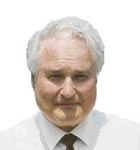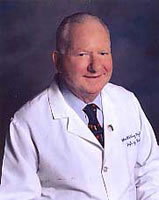Abstract
Computational fluid dynamics (CFD) studies of airflow in a digital reference model of the 17-generation
airway (bronchial tree) were accomplished using the FLUENT® computational code. The computational
mesh was based on the anatomical graph data of a digital reference model by Schmidt et al. (2004)
derived from High-Resolution Computer Tomography (HRCT) imaging of an in vitro preparation in
which specially adapted image processing algorithms were applied to delineate and segment the bronchi.
The 17-generation airway model containing 1453 bronchi was developed for the pressure drop and flow
field studies. The lung model consists of 6.744�106 unstructured tetrahedral computational cells. A steadystate
airflow rate of 28.3 L/min was used to simulate the transient turbulent flow regime using a Large
Eddy Simulation (LES) turbulence model. This CFD mesh represents the somewhat irregular but
anatomically realistic asymmetrical branching pattern of the larger airways, leading to varied airway
lengths and cross-sectional areas. It is demonstrated that the nature of the secondary vortical flows which
develop in such asymmetric airways varies with the specific anatomical characteristics of the branching
conduits.
1. Introduction
The uptake of particulate matter by inhalation leads to complex transport processes influenced by
unsteady convection through a non-dichotomously branching network of conducting conduits (airways).
The properties of the particulate matter (its particle geometry, diameter and density distributions, and its
affinity to adhere to the mucous linings of the conduits) play a crucial role in the subsequent uptake by,
and deposition pattern within, the pulmonary tract. While the respiratory tract may be the target organ of
concern with regard to many pollutants, for others it is merely one of several possible routes of entry into
the body. Furthermore, the pulmonary flow features are closely related to the anatomical details of the
branching network of some 23 generations of pulmonary airway conduits.
A widely used model for CFD simulations and predictions of gas transport, particle deposition
and dosimetry is that characterized by a regular, dichotomous branching pattern [Synder et al. (1981),
Zhao and Lieber (1994), Calay et al. (2002), Lee and Lee (2002), Liu et al. (2003), Kleinstreuer and
Zhang (2003), Nowak et al. (2003), Shi et al. (2004), Zhang and Kleinstreuer (2004)], a representation
that has its origin in the so-called trumpet model of Weibel (1963), who measured the dimensions of airway branches of a human lung distally to generation G4. Thereafter, his measurements were less complete down to generation G10, where only 10% of the branches were measured. Weibel�s study was used to develop the widely used symmetric model "A" corresponding to regular dichotomy. Nowak et al.
(2003) and Cebral and Summer (2004) used CT scans to characterize the pulmonary airways more
realistically, albeit only down to the 4th generation subunit (G0 to G4). Kriete et al. (2004) reported in a
conference paper the oxygen gas transport and particle deposition in a digital reference model based on
data by Schmidt et al. (2004) with a limited 29-terminal bronchi outlet; whereas, our study has been
based on the same data of Schmidt et al. (2004) but includes all 720 bronchi outlets. Their final mesh of
Kriete et al. contained a total of 456,463 prism and tetrahedral elements using the ICEM CFD software
package.
Calay et al. (2002) studied the respiratory flow patterns in a single first generation bifurcation
distal to the trachea and in a multiple-bifurcation model, with their three generations based on the
anatomy given by Horsfield et al. (1971). They used four different grid densities varying comprising
respectively 31104, 79820, 159872 and 320980 nodes. Lee and Lee (2002) generated a 3-D conduit
network model with four generations which conformed closely to Weibel�s 1963 model in order to study
aerosol bolus dispersion. The total number of cells in their 90� out-of-plane model ranged from 40,000 to
60,000. Liu et al. (2003) studied the 3-D inspiratory flow in a 3-generation asymmetric lung airway
model from the 5th to the 11th branches of Weibel�s model "B", corresponding to an irregular dichotomy. They used 123,591 tetrahedral elements for the unstructured mesh of the pulmonary airway. Kleinstreuer
and Zhang (2003) analyzed targeted aerosol drug deposition analysis in a rigid triple-bifurcation
pulmonary airway model. Their model represents the symmetrically bifurcating generations G3 to G6 as
in Weibel�s lung model with three different hemispherical tumor models placed along the side wall of the
G5 airway. Their final mesh comprised about 360,000 cells for the triple bifurcation configuration.
Nowak et al. (2003) demonstrated a four-subunit CFD simulation method for the human tracheobronchial
tree. They elected to economize on computational effort by segmenting the first 12 generations into four
3.5-generation "tranches" or subunits (G0-G3, G3-G6, G6-G9, and G9-G12), without adequately
accounting for the fluctuation in boundary conditions between each tranche or subunit. Additionally, they
compared the simulated Weibel-based anatomical model to the more realistic CT scan-based anatomical
model with a 4-generation subunit. They imported the CT scan-based lung image of Sauret et al. (1999)
as a surface mesh up to 9 generations. Their results indicate dramatic differences in the predicted particle
deposition patterns between the two models. The absence of airway curvature and surface irregularities in
a Weibel-based model renders the flow fields very different from those in a real human lung (CT-based
model). Shi et al. (2004) have studied the nanoparticle deposition in bifurcating tubes of a 3-generation
model (G3-G5 Weibel�s pulmonary airway model) for both planar and non-planar geometries. They used
892,008 computational cells for the planar G3-G5 pulmonary airway model and 845,000 for the nonplanar
one. Zhang and Kleinstreuer (2004) recently studied nanoparticle deposition in a human upper
airway model consisting of two connected segments of a simplified human cast replica extending from
the mouth to the trachea (generation G0), as adapted from a human cast and continuing with symmetric
bifurcations over generations G0 to G3, based upon Weibel�s model. They used 420,000 computational
cells for the oral airway and 670,000 cells for the four-generation pulmonary airway model. Cebral and
Summer (2004) studied the central tracheal and bronchial airways down to 4 generations by using a
virtual bronchoscopy reconstruction method. Airflow patterns resulting from airway stenoses in
generations from G0 to G4 were simulated computationally. van Ertbruggen et al. (2004) studied the gas
flow and particle deposition in a realistic 3D model of the bronchial tree, extending from the trachea to
the segmental bronchi (7th airway generation for the most distal airways). Their model was based on the
morphometrical data of Horsfield et al. (1971).
Realistic physical morphometry, incorporating a large number of generations, is essential for
adequately simulating fluid and particle dynamics in human pulmonary airways. In recent years, there have been several published research works [Kitaoka et al. (1999), Tawhai et al. (2000 and 2004), Spencer et al.
(2001), Tgavalekos et al. (2003), Sera et al. (2003), and Schmidt et al. (2004)] focusing on the generation of pulmonary airway models using both mathematical algorithm development and new experimental imaging
techniques. Kitaoka et al. (1999) introduced a 3D model of the human airway tree down to the terminal
bronchioles which was generated by a deterministic algorithm that incorporated duct branching and space
division. Tawhai et al. (2000 and 2004) developed a 3-D tree-growing algorithm for generating conducting
airway models specific to a given host geometry. The host geometrical surface was derived from Magnetic
Resonance Imaging (MRI). They included 29,445 terminal bronchioles in their model. Spencer et al. (2001)
developed a dynamic surface modeling technique based on data from idealized models (Weibel�s model
with symmetric, dichotomously branching morphology) to construct 3-D computer simulations of tubular
pulmonary airway structures within lungs extending from the trachea (Generation G0) to the alveoli
(Generation G23). Sera et al. (2003) developed a two-step method to visualize small airways in detail by
staining the lung tissue with a radio-opaque solution and then visualizing the tissue with a cone-beam
microfocal X-ray Computed Tomography (CT) system. They employed the Staining and CT (SCT)
imaging method to stain and visualize excised rodent pulmonary airways.
Tgavalekos et al. (2003) have advanced the 3-D airway tree model of Kitaoka et al. (1999) to
predict pulmonary function on the basis of airway structure, particularly when constriction patterns are
imposed heterogeneously on the pulmonary tree in specific anatomic locations. They also introduced
pulmonary function into a 3-D model which allows specific control of anatomical regions, and compared
their model predictions with ventilation images obtained from Positron Emission Tomography (PET) and
measurements of dynamic mechanical pulmonary function. They generated 50,400 computational airway
cells with their model.
2. Current 17-generation anatomical model
We have based our present CFD analysis on the best published anatomically explicit human lung
model available to date; i.e. the 17-generation anatomical model developed by Schmidt et al. (2004). Fig. 1
depicts their bronchial tree models as derived from High-Resolution Computed Tomography (HRCT)
imaging of an in vitro preparation. Their model data represent the anatomy of the human lung of an adult
male, free of pathological alterations. Fig. 1a portrays a realistic 3D surface representation of the
segmented volume of the bronchial tree. The cartilaginous rings can be observed in the main upper
generations. The conduit model reconstructed from an abstracted and adapted topological graph, as
shown in Fig. 1b, contains 1453 bronchi up to the 17th Horsfield order. To the authors´ knowledge, the
computational study described herein represents the first published CFD simulation of the airflow in a
digital reference model up to a maximum 17 generations of the human pulmonary airways with 1453
bronchi. The entire human lung is comprised of some 26 generations of branching pulmonary airway
conduits. The computer-generated symmetric human lung model of Spencer et al. (2001) for the 23-
generation tree does not possess the detail required for the current computational investigation and is not
as accurate as the Schmidt et al. (2004) anatomical airway model.
3. CFD simulation
The characterization of the anatomy and morphometry of the airways constitutes the first step in
an examination
. . . Continue to article and footnotes (PDF).
Dr. Richard Collins is the Former University Professor of Biomedical and Human Factors Engineering, Professor of Medicine, Professor of Mechanical and Aerospace Engineering. Dr. Collins has Demonstrated Accuracy in Research and Scientific Analysis in Mechanical and Biomechanical Engineering and Regulatory Assessments. His work has been Extensively Published in National and International peer-reviewed Literature. He is an Internationally recognized engineering and medical expert, having earned his Ph.D. from the University of California, Berkeley. Dr. Collins is qualified as an expert witness in civil and criminal courts.
See Dr. Collins´ Profile on Experts.com.
©Copyright - All Rights Reserved
DO NOT REPRODUCE WITHOUT WRITTEN PERMISSION BY AUTHOR.











